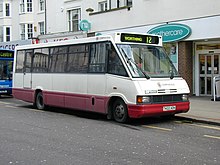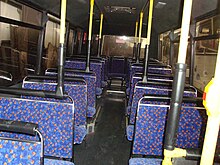Optare MetroRider
| Optare MetroRider | |
|---|---|

Optare MetroRider Series 4 T422 ADN in service with Compass Travel seen here in Worthing Town Centre. This is the later wide-bodied model, and was one of two demonstrators (the other being T421 ADN, also now operated by Compass).
|
|

Optare metrorider Interior
|
|
| Overview | |
| Manufacturer | Optare |
| Body and chassis | |
| Doors | 1 door |
| Floor type | Step entrance |
| Powertrain | |
| Engine | Cummins B Series engine |
| Transmission | Allison AT545/World Series automatic |
| Chronology | |
| Successor | Optare Solo |
The Optare MetroRider is a midibus that was built by Optare between 1989 and 2000. Optare based the original design on the MCW Metrorider after Optare bought the rights following a decision by MCW to end bus production. This model also replaced the less successful StarRider and the replacement of this model is the low-floor Optare Solo.
The MetroRider is an integral bus, which means the chassis and body are constructed as a single structure. It had many options, and was available in three lengths and two widths. In addition, Optare offered the option of a protruding, more substantial, destination display (blind-box), as opposed to the flat on the body destination display.
In later years, the MetroRider could be ordered with a one-piece rather than a standard two-piece windscreen which, in turn, became standard. Among the most popular versions was the basic model, with short length, standard 1 door and no blind-box.
These buses are widely dispersed across the UK and were, for example, popular with some independent operators in rural settings such as Emsworth & District and Compass Travel in Worthing, the latter operating the last ever MetroRider (W426 CWX), from April 2000. In its prime, the MetroRider was also sold abroad in kit form, in countries such as Malaysia. The successor to the MetroRider is the low-floor Optare Solo.
An electric version of the MetroRider was produced in 1993. The transport authority placed four vehicles into service on a city centre circular service in Oxford. They were operated initially by the Oxford Bus Company but later briefly passed to Stagecoach Group before withdrawal owing to a cessation of subsidy. They were later used on Jersey and Islay.
...
Wikipedia
